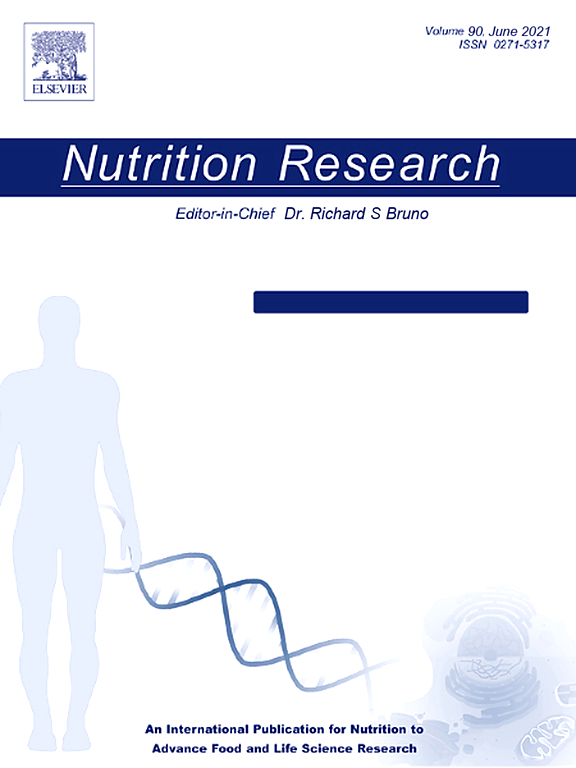通过烹调方法摄入鱼类对血脂异常可能性的影响:来自希腊国家营养和健康调查的结果。
IF 3.1
3区 医学
Q2 NUTRITION & DIETETICS
引用次数: 0
摘要
营养指南强调食用鱼类,因为据报道它对健康有益,尽管基于所使用的烹饪方法的潜在差异影响尚未得到充分调查。假设鱼的摄入量和制备方法可能会影响脂质浓度,我们的目的是检查希腊成年人遵守膳食指南的鱼摄入量,并评估鱼摄入量与血脂异常可能性之间的关系。通过24小时召回和经过验证的食物倾向问卷,对3742名成年人(年龄≥19岁,59.3%为女性)的鱼类消费者进行了识别。使用调整后的logistic回归模型,对总摄入量、非油炸和油炸鱼的消费者进行血脂异常可能性的估计。鱼类消费者患病率为17.9% (n = 668), 20.8% (n = 139)报告油炸。根据食物倾向问卷,并结合两次24小时召回,67.7%的鱼类消费者和66.9%的炸鱼消费者每月食用不到一次,导致每周摄入量的中位数分别为23.7 (13.7,56.7)g和26.2 (15.0,70.4)g。每摄入1克鱼,血脂异常的几率会降低3%但每月食用1至3次炸鱼与本文章由计算机程序翻译,如有差异,请以英文原文为准。
Impact of fish intake on dyslipidemia likelihood by cooking method: Results from the Hellenic National Nutrition and Health Survey
Nutritional guidelines emphasize fish consumption due to its reported health benefits, although the potential differential effects based on the cooking method used have not been well investigated. Hypothesizing that fish consumption and preparation method may affect lipid concentrations, we aimed to examine fish consumption per dietary guidelines adherence and assess the association between fish intake and dyslipidemia likelihood in Greek adults. Fish consumers were identified using 24-hour recalls and a validated Food Propensity Questionnaire from 3742 adults (aged ≥19 years, 59.3% females). Dyslipidemia likelihood was estimated using adjusted logistic regression models, for total intake, and for nonfried and fried-fish consumers. Prevalence of fish consumers was 17.9% (n = 668), and 20.8% (n = 139) reported frying it. Based on the Food Propensity Questionnaire, and in combination with the two 24-hour recalls, 67.7% of fish consumers and 66.9% of fried-fish consumers consumed it less than once per month, resulting in a median weekly intake of 23.7 (13.7, 56.7) g and 26.2 (15.0, 70.4) g, respectively. For each gram of total fish intake, the odds of dyslipidemia decreased by 3% but consuming fried fish 1 to 3 times /month compared to <1 per month, increased the odds by 3.6% (odds ratio, 3.6; 95% confidence interval, 1.19–10.70). Greek adults do not adhere to the dietary guidelines for fish consumption in terms of weekly intake and a large proportion consume it fried. Both factors may lead to a further increased likelihood of dyslipidemia and not to a protective effect. Public health educational awareness programs are required to increase the frequency of fish consumption, with emphasis given on cooking methods.
求助全文
通过发布文献求助,成功后即可免费获取论文全文。
去求助
来源期刊

Nutrition Research
医学-营养学
CiteScore
7.60
自引率
2.20%
发文量
107
审稿时长
58 days
期刊介绍:
Nutrition Research publishes original research articles, communications, and reviews on basic and applied nutrition. The mission of Nutrition Research is to serve as the journal for global communication of nutrition and life sciences research on diet and health. The field of nutrition sciences includes, but is not limited to, the study of nutrients during growth, reproduction, aging, health, and disease.
Articles covering basic and applied research on all aspects of nutrition sciences are encouraged, including: nutritional biochemistry and metabolism; metabolomics, nutrient gene interactions; nutrient requirements for health; nutrition and disease; digestion and absorption; nutritional anthropology; epidemiology; the influence of socioeconomic and cultural factors on nutrition of the individual and the community; the impact of nutrient intake on disease response and behavior; the consequences of nutritional deficiency on growth and development, endocrine and nervous systems, and immunity; nutrition and gut microbiota; food intolerance and allergy; nutrient drug interactions; nutrition and aging; nutrition and cancer; obesity; diabetes; and intervention programs.
 求助内容:
求助内容: 应助结果提醒方式:
应助结果提醒方式:


